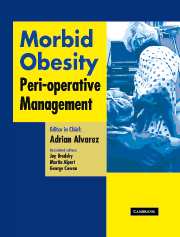Book contents
- Frontmatter
- Contents
- Contributors
- Foreword
- Preface
- Acknowledgments
- Dedication
- Section 1 General aspects
- 1 Introduction to peri-operative management: reasons for a multidisciplinary approach
- 2 Peri-operative risks and frequent complications
- 3 Informed consent in bariatric surgery and anesthesia
- Section 2 Pathophysiology
- Section 3 Pre-operative management
- Section 4 Peri-operative management of co-morbidities
- Section 5 Pharmacology
- Section 6 Monitoring
- Section 7 Intra-operative management
- Section 8 Post-operative care
- Section 9 Conclusions
- Afterword
- Index
1 - Introduction to peri-operative management: reasons for a multidisciplinary approach
from Section 1 - General aspects
Published online by Cambridge University Press: 17 August 2009
- Frontmatter
- Contents
- Contributors
- Foreword
- Preface
- Acknowledgments
- Dedication
- Section 1 General aspects
- 1 Introduction to peri-operative management: reasons for a multidisciplinary approach
- 2 Peri-operative risks and frequent complications
- 3 Informed consent in bariatric surgery and anesthesia
- Section 2 Pathophysiology
- Section 3 Pre-operative management
- Section 4 Peri-operative management of co-morbidities
- Section 5 Pharmacology
- Section 6 Monitoring
- Section 7 Intra-operative management
- Section 8 Post-operative care
- Section 9 Conclusions
- Afterword
- Index
Summary
Introduction
Morbid obesity has always been a challenge to the anesthesiologist and surgeon. In the past, it was frequent to avoid any surgical procedure due to the increased risk observed among these subjects. It was common to hear, “if you do not lose weight you cannot be operated …”.
But this situation have changed, mainly in the last two decades.
Morbid obesity is actually one of the most prominent medical problems in the world. Two aspects support this concept: quantitative and qualitative.
Quantitative
Obesity prevalence is increasing. It has been recently reported that the incidence of all classes of obesity, those with body mass indexes (BMI) of 30, 40, or 50 kg/m2 have shown a dramatic growth from 1986 to 2000. One in five patients has a BMI over 30, one in 50 over 40, and one in 400 has a BMI over 50.
Similar incidence and tendency have been observed in the rest of the world.
Qualitative
Morbid obesity is a life-threatening situation in the long term. BMI over 40 if not treated, significantly shortens the individual's life expectancy. Apart from the increased morbidity associated with obesity, the excess mortality is substantial. It is principally caused by death from coronary heart disease, stroke, and diabetes mellitus, although sudden unexplained death, malignancies, and fatal accidents are also more prevalent in the obese.
- Type
- Chapter
- Information
- Morbid ObesityPeri-Operative Management, pp. 3 - 12Publisher: Cambridge University PressPrint publication year: 2004



